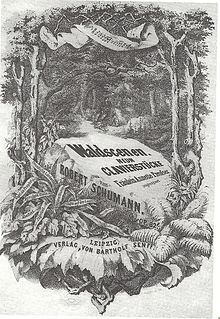Forest scenes
Forest Scenes , Op. 82, one of nine piano pieces (is character pieces ) existing cycle of Robert Schumann , which was built between 1848 and 1849. It differs from the Children's Scenes, Op. 15, through a stronger symmetry in the formal structure and a closer tonal connection through the restriction to a few related keys . The piece Vogel als Prophet achieved particular fame and "has been at home in the concert hall as a touchstone of pianistic touch since Anton Rubinstein ". Dedication: Composer and Fraulein Annette Preusser dedicated .
construction
| title | key | Presentation designation | Tact | metronome |
|---|---|---|---|---|
| 1. Entry | B flat major | Not too fast | 4/4 |
|
| 2. Hunters on the lookout | D minor | Very lively | 4/4 |
|
| 3. Lonely flowers | B flat major | Easy | 2/4 |
|
| 4. Disreputable body | D minor | Pretty slow | 4/4 |
|
| 5. Friendly landscape | B flat major | Fast | 2/4 |
|
| 6. Hostel | E flat major | Moderate | 4/4 |
|
| 7. Bird as a prophet | G minor | Slowly, very gently | 4/4 |
|
| 8. Hunting song | E flat major | Fast, strong | 6/8 |
|
| 9. Farewell | B flat major | Not fast | 4/4 |
|
Symmetries
The sequence of the pieces shows the striving for a largely symmetrical architecture of the cycle. The first piece ( entry ) corresponds to the last ( farewell ), the second ( hunters on the lookout ) with the penultimate ( hunting song ). The third piece ( lonely flowers ) is thematically related to the third from last ( bird as prophet ): flowers and birds are both representatives of animate nature. The Verrufene point finally corresponds to the cozy contrasting as eerie place hostel . All these pieces are arranged around the fifth piece ( friendly landscape ) as an axis of symmetry.
Keys
The main key of B major determines the beginning, middle and end of the cycle. The Lonely Flowers also use B flat major, while the thematically corresponding bird as prophet (probably because of its more mysterious character) is in the parallel key in G minor. It is also noteworthy that the two eerie pieces ( Hunter on the Lauer and Disreputable Passage ) are in D minor, while their positive counterparts ( Jagdlied and Inn ) are both in E flat major.
Literary references
The following poetry verses by Friedrich Hebbel are prefixed as the motto of the fourth piece Ver Rufene Stelle :
The flowers, as tall as they grow,
are pale here, like death;
Only one in the middle
stands there in the dark red.
It didn't get it from the sun:
its glow never met it;
She got it from the earth,
and she drank human blood.
These verses are one of a total of seven literary mottos that Schumann noted for the individual pieces on the last page of his engraver's copy from 1850. Three of them are from the collection Forest songs by Gustav Pfarrius . Since this volume of poetry was not published until 1850 and some of the piano pieces were already composed at the end of 1849, it can be concluded that Schumann did not link literary references to his pieces from the start, but added them later - following a common practice at the time. However, since he had a rather cautious to negative attitude towards program music (see children's scenes: Relationship to program music), he must have had concerns before going to press about bringing his compositions too close to program music due to literary overload. Therefore almost all mottos were deleted from the first edition of December 1850, with the exception of the one quoted above.
Individual evidence
- ↑ Werner Oehlmann (Ed.): Reclams Klaviermusikführer Vol. 2, Stuttgart 1967, p. 299
- ↑ Irmgard Knechtges-Obrecht: Waldszenen , in: Helmut Loos (ed.): Robert Schumann, interpretations of his works , Laaber Verlag, 2005, ISBN 3-89007-447-2 , vol. 2, page 72
Web links
- Waldszenen, Op.82 (Schumann, Robert) : Sheet music and audio files in the International Music Score Library Project
- Detailed explanations of the forest scenes (PDF; 262 kB)
- Sound recording with Jörg Demus (notes can be read) on YouTube

